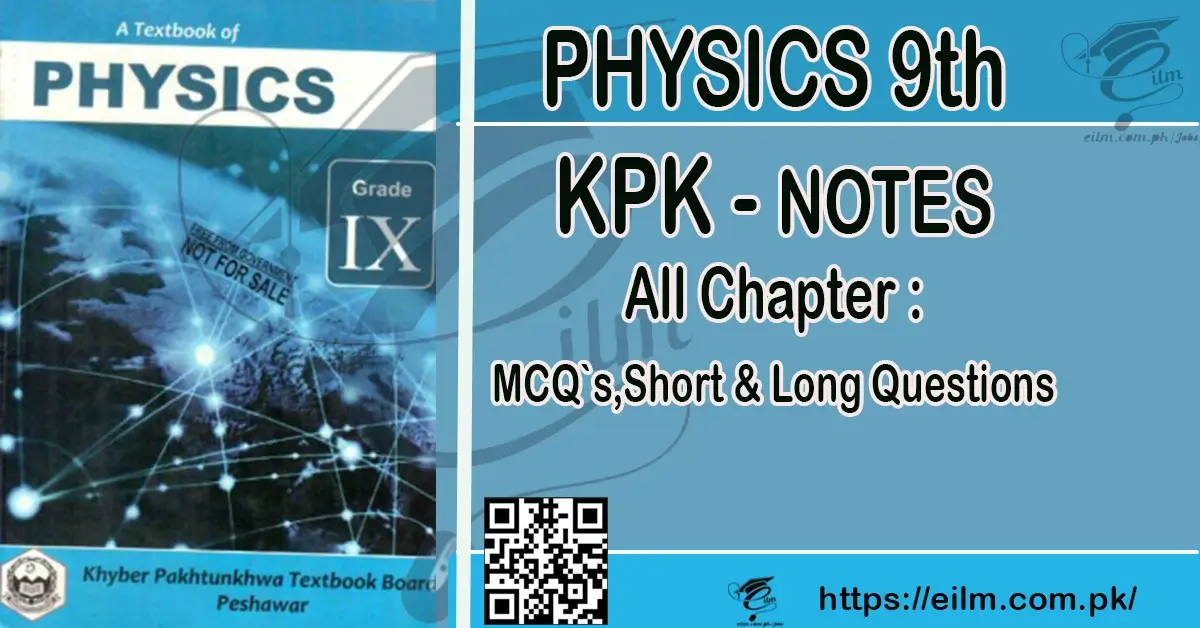Class 9th KPK Math Notes Download free Math Notes
Class 9 kpk math notes comprise the analysis and explanation of all the problems covered by the KPK textbook for 9th grade. The solutions, MCQS and Review exercises are provided in a detailed manner to ensure that students can understand concepts as they go through them. These class 9 math KPK notes are prepared by some of the most our accomplished experts in the field of Mathematics. In this article, we will provide you with the best and quality free Class 9th Math KPK notes in PDF.
KPK Class 9 Maths Notes PDF Download
Many students often worry about finding free PDF notes to assist them with their studies. In response to this concern, we have taken the initiative to upload free class 9th math notes in PDF format. These notes are conveniently organized into chapters so that students can easily navigate to the specific content they need. To access these notes, all you need to do is click on your desired chapter, and the PDF file will be readily available for download. With these notes, students can easily review and reinforce their understanding of class 9 math concepts without any additional cost. Our hope is that these free PDF class 9th math notes will serve as a valuable resource for students in their pursuit of academic excellence.
9 Maths Notes KPK Latest Updated Free PDF Notes KPK Syllabus
“ Gaining knowledge ,is the first step to wisdom,Sharing it ,is the first step to Huminity”
Class 9th Math KPK notes Textbook Syllabus Free Notes
If you are a student of class 9th in KPK and searching for math notes to prepare for board exams, you can now find complete notes on EIlm.com.pk. These notes are based on the latest syllabus provided by the KPK Textbook Board curriculum and are prepared according to the paper pattern for class 9 math exams all over KPK. It’s worth mentioning that the KPK BISE Peshawar has recently decided to conduct SLO based paper for class 9th. Therefore, the notes available at EIlm.com.pk are specifically prepared according to the latest SLO (Student Learning Outcome) examination syllabus.Students appearing in the following Boards of KPK can get consultation from these free class 9th math kpk notes.
- BISE Peshawar
- Abbottabad
- Bannu
- Dera Ismail khan.
- Kohat
- Malakand
- Mardan
- Swat
KPK Class 9 Math Notes Chapter Wise Details
Unit 1 Matrices and Determinants
The unit 1 class 9th notes will help the students to clear the following key concepts.
- Define a matrix with real entries and relate its rectangular layout (formation) with real life,
• rows and columns of a matrix,
• the order of a matrix,
• equality of two matrices. - Define and identify row matrix, column matrix, rectangular matrix,
square matrix, zero/null matrix, diagonal matrix, scalar matrix,
identity matrix, transpose of a matrix, symmetric and skew symmetric matrices. - Know whether the given matrices are suitable for addition/
subtraction. - Add and subtract matrices.
- Multiply a matrix by a real number.
- Verify commutative and associative laws under addition.
- Define additive identity of a matrix.
- Find additive inverse of a matrix.
- Know whether the given matrices are suitable for multiplication.
- Multiply two (or three) matrices.
- Verify associative law under multiplication.
- Verify distributive laws.
- Show with the help of an example that commutative law under
multiplication does not hold in general (i.e., AB ≠ BA). - Define multiplicative identity of a matrix.
- Verify transpose of matrix result.
- Define the determinant of a square matrix.
- Evaluate determinant of a matrix.
- Define singular and non-singular matrices.
- Find multiplicative inverse of a non-singular matrix A and verify
that AA-1 = I = A-1A where I is the identity matrix.
Unite 2 REAL AND COMPLEX NUMBERS
The numbers are the foundation of mathematics and we use different kinds of numbers in our daily life. So it is necessary to be familiar with various kinds of numbers In this unit we shall discuss real numbers and complex numbers including their properties. After studying this unit the student will be able to understand the concepts of following difficult topics.
- After studying this unit, the students will be able to:
- Recall the set of real numbers as a union of sets of rational and irrational numbers.
- Depict real numbers on the number line.
- Demonstrate a number with terminating and non-terminating recurring decimals on the number line. • Give decimal representation of rational and irrational numbers.
- Know the properties of real numbers.
- Explain the concept of radicals and radicands.
- Differentiate between radical form and exponential form of an expression.
- Transform an expression given in radical form to an exponential form and vice versa.
- Recall base, exponent and value.
- Apply the laws of exponents to simplify expressions with real exponents.
- Define complex number z represented by an expression of the form z a ib = + , where a and b are real numbers and i = -1
- Recognize a as real part and b as imaginary part of z = a + ib.
- Define conjugate of a complex number. • Know the condition for equality of complex numbers.
- Carry out basic operations (i.e., addition, subtraction, multiplication and division) on complex numbers.
Unite 03 LOGARITHMS
The difficult and complicated calculations become easier by using logarithms. Abu Muhammad Musa Al Khwarizmi first gave the idea of logarithms. Later on, in the seventeenth century John Napier extended his work on logarithms and prepared tables for logarithms.
He used “e” as the base for the preparation of logarithm tables. Professor Henry Briggs had a special interest in the work of John Napier. He prepared logarithm tables with base 10. Antilogarithm table was prepared by Jobst Burgi in 1620 A.D
After studying this unit, the students will be able to:
- express a number in standard form of scientific notation and vice versa.
- define logarithm of a number y to the base a as the power to which a must be raised to give the number (i.e., ax = y ⇔ loga y = x, a > 0,
- a ≠ 1 and y > 0).
- define a common logarithm, characteristic and mantissa of log of a number.
- use tables to find the log of a number.
- give concept of antilog and use tables to find the antilog of a number.
- differentiate between common and natural logarithm. prove the following laws of logarithm
- loga (mn) = loga m + loga n,
- loga ( ) = loga m – loga n,
- loga mn = nloga m,
- loga m logmn = loga n.
- apply laws of logarithm to convert lengthy processes of multiplication, division and exponentiation into easier processes of addition and subtraction etc.
Unite 04 Algebraic expressions and algebraic formulas
Algebra is a generalization of arithmetic. Recall that when operations of addition and subtraction are applied to algebraic terms, we obtain an algebraic expression. For instance, 5×2 – 3x + 2 x and 3xy + 3 x (x ≠ 0) are algebraic expressions. After studying this unit, the students will be able to:
- Know that a rational expression behaves like a rational number.
- Define a rational expression as the quotient p( x) / q (x ) of two polynomials p(x) and q(x)
- Where q(x) is not the zero polynomial.
- Examine whether a given algebraic expression is a
- polynomial or not,
- rational expression or not.
- Define p( x)/ q (x ) as a rational expression in its lowest terms if p(x) and q(x) are polynomials with integral coefficients and having no common factor.
- Examine whether a given rational algebraic expression is in lowest from or not.
- Reduce a given rational expression to its lowest terms.
- Find the sum, difference and product of rational expressions.
- Divide a rational expression with another and express the result in it lowest terms.
- Find value of algebraic expression for some particular real number. Know the formulas
- (a + b) 2 + (a – b) 2 = 2(a2 + b2),
- (a + b) 2 – (a – b) 2 = 4ab
- Find the value of a2 + b2 and of ab when the values of a + b and a – b are known.
- Know the formulas (a + b + c) 2 = a2 + b2 + c2 + 2ab + 2bc + 2ca.
- find the value of a2 + b2 + c2 when the values of a + b + c and ab + bc + ca are given.
- find the value of a + b + c when the values of a2 + b2 + c2 and ab + bc + ca are given.
- find the value of ab + bc + ca when the values of a2 + b2 + c2 and a + b + c are given
- (a + b) 3 = a3 + 3ab(a + b) + b3,
- (a – b) 3 = a3 – 3ab(a – b) – b3,
- find the value of a3 ± b3 when the values of a ± b and ab are given
- find the value of x3 ± when the value of x ± is given.
- know the formulas
- a3 ± b3 = (a ± b)(a2 ± ab + b2).
- find the continued product of (x + y) (x – y) (x2 + xy + y2 ) (x2 – xy + y2 ).
- recognize the surds and their application.
- explain the surds of second order. Use basic operations on surds of second order to rationalize the denominators and evaluate it.
Unite 05 Factorization
Factorization plays an important role in mathematics as it helps to reduce the study of a complicated expression to the study of simpler expressions. In this unit, we will deal with different types of factorization of polynomials. After studying this unit, the students will be able to:
- ka + kb + kc
- ac + ad + bc + bd
- a2 + 2ab + b2
- a2 – b2
- a2 + 2ab + b2 – c2
- Factorize the expressions of the following types.
- Type I: a4 + a2 b2 + b4 or a4 + 4b4
- Type II: x2 + px + q
- Type III: ax2 + bx + c
- Type IV: (ax2 + bx + c) (ax2 + bx + d) + k
- (x + a) (x + b) (x + c) (x + d) + k
- (x + a) (x + b) (x + c) (x + d) + kx2
- Type V: a3 + 3a2 b + 3ab2 + b3 a3 − 3a2 b + 3ab2 − b3
- Type VI: a3 + b3
- State and prove remainder theorem and explain through examples.
- Find Remainder (without dividing) when a polynomial is divided by a linear polynomial.
- Define zeros of a polynomial.
- State and prove Factor theorem.
- Use Factor theorem to factorize a cubic polynomial.
Unit 06 ALGEBRAIC MANIPULATION
In this unit we will first deal with finding H.C.F. and L.C.M. of algebraic expressions by factorization and long division. Then by using H.C.F. and L.C.M. we will simplify fractional expressions. Toward the end of the unit finding square root of algebraic expression by factorization and division will be discussed.
After studying this unit, the students will be able to:
- Find Highest Common Factor and Least Common Multiple of algebraic expressions.
- Use factor or division method to determine Highest Common Factor and Least Common Multiple.
- Know the relationship between H.C.F. and L.C.M.
- Solve real life problems related to H.C.F. and L.C.M.
- Use Highest Common Factor and Least Common Multiple to reduce fractional expressions involving + , – , # , ÷ .
- Find square root of algebraic expressions by factorization and division.
Unite 07 LINEAR EQUATIONS AND INEQUALITIES
In this unit we will extend the study of previously learned skills to the solution of equations with rational coefficients of Unit 2 and the equations involving radicals and absolute value. Finally, after defining inequalities, and recalling their trichotomy, transitive, additive and multiplicative properties we will use them to solve linear inequalities with rational coefficients.
After studying this unit, the students will be able to:
- Recall linear equation in one variable.
- Solve linear equation with rational coefficients.
- Reduce equations, involving radicals, to simple linear form and find their solutions.
- Define absolute value.
- Solve the equation, involving absolute value, in one variable.
- Define inequalities ( >, , <)
- Recognize properties of inequalities (i.e., trichotomy, transitive, additive and multiplicative). • Solve linear inequalities with rational coefficients.
Unite 09 INTRODUCTION TO COORDINATE GEOMETRY
After studying this unit, the students will be able to:
- Define coordinate geometry.
- Derive distance formula to calculate distance between two points given in Cartesian plane.
- Use distance formula to find distance between two given points.
- Define collinear points. Distinguish between collinear and non-collinear points.
- Use distance formula to show that given three (or more) points are collinear.
- Use distance formula to show that the given three non-collinear points form
- an equilateral triangle
- an isosceles triangle,
- a scalene triangle
- a right angled triangle
- Use distance formula to show that given four non-collinear points form
- a square
- a rectangle
- a parallelogram
- Recognize the formula to find the midpoint of the line joining two given points.
- Apply distance and mid point formulae to solve/verify different standard results related to geometry.
Unite 17 PRACTICAL GEOMETRY –TRIANGLES
In this unit we shall learn to construct different triangles, rectangles, squares etc. The knowledge of these basic constructions is very useful in every day life, especially in the occupations of woodworking, graphic art and metal trade etc. Intermixing of geometrical figures is used to create artistic look. The geometrical constructions are usually made with the help of a pair of compasses, set squares, dividers and a straight edge.
After studying this unit, the students will be able to:
- Construct a triangle having given: two sides and the included angle, one side and two of the angles, two of its sides and the angle opposite to one of them and two of them angles, two of its sides and the angle opposite to one of them (with all the three possibilities).
- Draw: angle bisectors, altitudes, perpendicular bisectors, medians, of a given triangle and verify their concurrency.
- Construct a triangle equal in area to a given quadrilateral. Construct a rectangle equal in area to a given triangle. Construct a square equal in area to a given rectangle. Construct a triangle of equivalent area on a base of given length.
Class 10th Notes Punjab Board


Join EILM.COM.PK Learning Program
Student’s also look the latest Posts,Exam Tips, and more.











